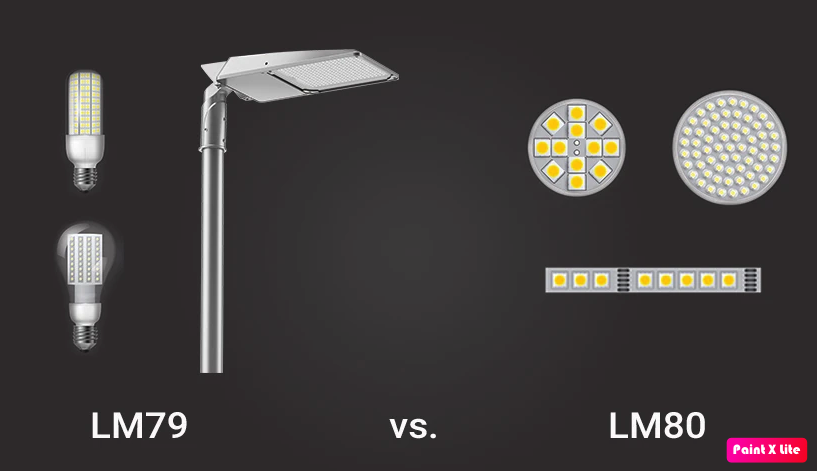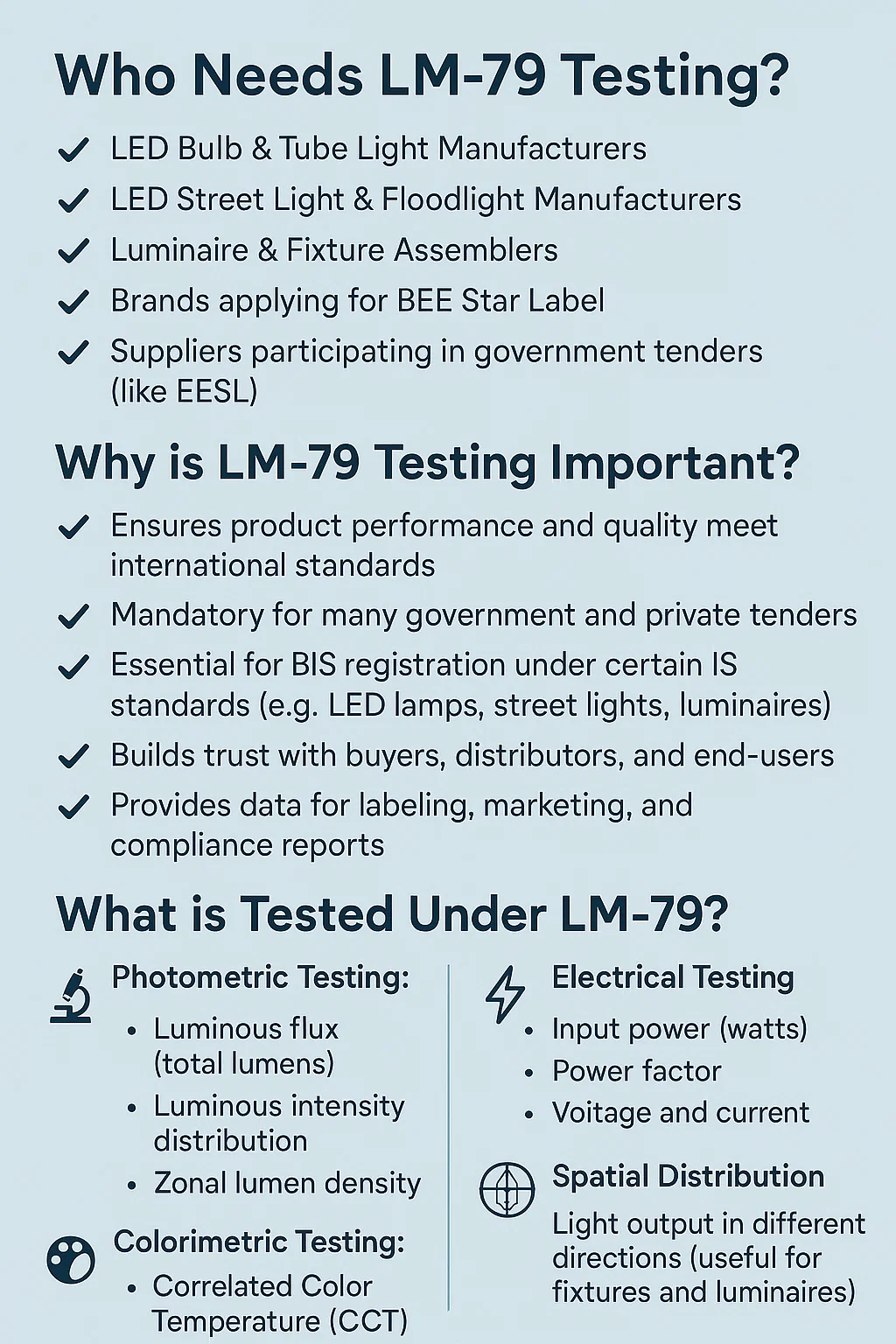What is LM-79 Testing?
LM-79 is an approved test procedure developed by the Illuminating Engineering Society of North America (IESNA) for measuring the performance characteristics of LED-based lighting products.
It provides electrical and photometric measurements including:
-
Luminous flux (total light output)
-
Luminous efficacy
-
Light distribution
-
Color characteristics (CCT, CRI, chromaticity)
LM-79 testing is crucial for verifying the performance claims of LED lighting products and is often required for energy efficiency certifications such as BEE Star Labeling, BIS CRS, or for meeting international standards like ENERGY STAR.
Who Needs LM-79 Testing?
✔️ LED Bulb & Tube Light Manufacturers
✔️ LED Street Light & Floodlight Manufacturers
✔️ Luminaire & Fixture Assemblers
✔️ Brands applying for BEE Star Label
✔️ Suppliers participating in government tenders (like EESL)
Why is LM-79 Testing Important?
✔️ Mandatory for many government and private tenders
✔️ Essential for BIS registration under certain IS standards (e.g., LED lamps, street lights, luminaires)
✔️ Builds trust with buyers, distributors, and end-users
✔️ Provides data for labeling, marketing, and compliance reports

What is Tested Under LM-79?
🔬 Photometric Testing:
-
Luminous flux (total lumens)
-
Luminous intensity distribution
-
Zonal lumen density
🌈 Colorimetric Testing:
-
Correlated Color Temperature (CCT)
-
Color Rendering Index (CRI)
-
Chromaticity coordinates
⚡ Electrical Testing:
-
Input power (watts)
-
Power factor
-
Voltage and current
💡 Spatial Distribution:
-
Light output in different directions (useful for fixtures and luminaires)
Required Documents for LM-79 Testing
To begin LM-79 testing, you’ll typically need:
-
Product technical datasheet
-
Detailed circuit diagram
-
User manual (if any)
-
Photographs of the product
-
Declaration of model numbers/variants
-
Samples — usually 2 to 5 units in working condition

Frequently Asked Questions (FAQs) on LM-79 Testing
🔹 Q1: What is LM-79 testing used for?
Answer: LM-79 testing measures the electrical and photometric performance of LED lighting products. It is needed to prove your product’s quality, efficiency, and compliance with Indian or international standards — especially for BIS certification, BEE Star Labelling, EESL tenders, and exports.
🔹 Q2: Which products need LM-79 testing?
Answer: Any LED-based lighting product like LED bulbs, tube lights, panel lights, street lights, flood lights, downlighters, and luminaires must undergo LM-79 testing if you want to claim accurate performance data or get certifications like BEE Star Label or BIS ISI mark.
🔹 Q3: Who can perform LM-79 testing?
Answer: LM-79 tests must be done in a NABL-accredited laboratory or any lab approved by BIS/BEE for official certification. Reports from unaccredited labs are not valid for regulatory approvals.
🔹 Q4: How many samples are needed for LM-79 testing?
Answer: Typically, labs ask for 2 to 4 working samples of each model to test various parameters. The exact number may vary depending on the product and lab’s test setup.
🔹 Q5: How long does LM-79 testing take?
Answer: On average, LM-79 testing takes 5 to 10 working days after the lab receives the complete samples and documents. The timeline may vary depending on the lab’s workload and product complexity.
🔹 Q6: How long is an LM-79 report valid?
Answer: There is no expiry date, but if you change your product’s design, driver, LED chip, or housing, you must retest. Also, BIS or BEE may ask for fresh reports if new standards apply or during license renewal.
🔹 Q7: What is the difference between LM-79 and LM-80?
Answer:
-
LM-79: Measures performance parameters like luminous flux, efficacy, CCT, CRI, beam angle, etc., for the whole luminaire.
-
LM-80: Measures lumen maintenance over time for the LED chip to predict how it performs after 6000 to 10,000 hours of use.
🔹 Q8: Is LM-79 testing mandatory for BIS registration?
Answer: Yes, for products covered under BIS CRS or ISI scheme, a valid LM-79 test report is required. Similarly, it is compulsory for BEE Star Label registration of LED products.
🔹 Q9: Can I use the same LM-79 report for multiple certifications?
Answer: Generally yes — the same report can be used for BIS CRS, BEE Star Label, and other regulatory submissions, provided the product model remains unchanged and the report is within the acceptable validity.
🔹 Q10: Can Bharati Global Compliances help me with LM-79 testing?
Answer: Yes! We coordinate with NABL & BIS-approved labs, ensure accurate testing, help with sample preparation, and provide end-to-end support to secure your BIS, BEE, or export certifications — smoothly and on time.
✨ Still Have Questions?
📞 Feel free to contact us for a FREE consultation — we’ll guide you step by step!
How Bharati Global Compliances Helps You
At Bharati Global Compliances, we provide complete support for LM-79 testing and related certifications.
Our end-to-end services include:
✔️ Guidance on documentation and sample preparation
✔️ Follow-ups to ensure timely test reports
✔️ Using the LM-79 reports for BIS, BEE, or export compliance
✔️ One-stop support for product testing, regulatory filing, and renewals